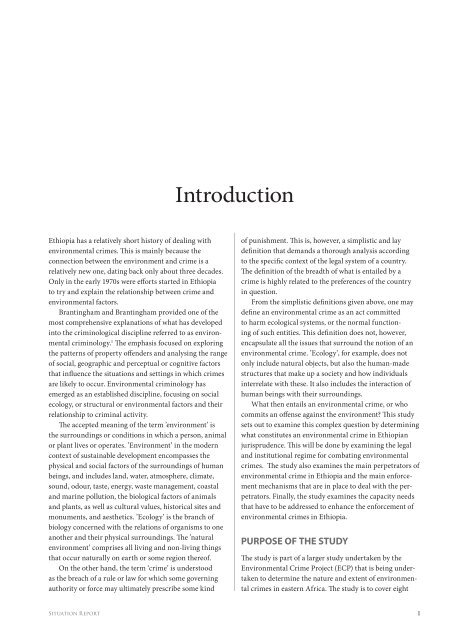4466 Environmental Crimes in Ethiopia.indd
4466 Environmental Crimes in Ethiopia.indd
4466 Environmental Crimes in Ethiopia.indd
Create successful ePaper yourself
Turn your PDF publications into a flip-book with our unique Google optimized e-Paper software.
Introduction<br />
<strong>Ethiopia</strong> has a relatively short history of deal<strong>in</strong>g with<br />
environmental crimes. This is ma<strong>in</strong>ly because the<br />
connection between the environment and crime is a<br />
relatively new one, dat<strong>in</strong>g back only about three decades.<br />
Only <strong>in</strong> the early 1970s were efforts started <strong>in</strong> <strong>Ethiopia</strong><br />
to try and expla<strong>in</strong> the relationship between crime and<br />
environmental factors.<br />
Brant<strong>in</strong>gham and Brant<strong>in</strong>gham provided one of the<br />
most comprehensive explanations of what has developed<br />
<strong>in</strong>to the crim<strong>in</strong>ological discipl<strong>in</strong>e referred to as environmental<br />
crim<strong>in</strong>ology. 1 The emphasis focused on explor<strong>in</strong>g<br />
the patterns of property offenders and analys<strong>in</strong>g the range<br />
of social, geographic and perceptual or cognitive factors<br />
that <strong>in</strong>fluence the situations and sett<strong>in</strong>gs <strong>in</strong> which crimes<br />
are likely to occur. <strong>Environmental</strong> crim<strong>in</strong>ology has<br />
emerged as an established discipl<strong>in</strong>e, focus<strong>in</strong>g on social<br />
ecology, or structural or environmental factors and their<br />
relationship to crim<strong>in</strong>al activity.<br />
The accepted mean<strong>in</strong>g of the term ’environment’ is<br />
the surround<strong>in</strong>gs or conditions <strong>in</strong> which a person, animal<br />
or plant lives or operates. ’Environment’ <strong>in</strong> the modern<br />
context of susta<strong>in</strong>able development encompasses the<br />
physical and social factors of the surround<strong>in</strong>gs of human<br />
be<strong>in</strong>gs, and <strong>in</strong>cludes land, water, atmosphere, climate,<br />
sound, odour, taste, energy, waste management, coastal<br />
and mar<strong>in</strong>e pollution, the biological factors of animals<br />
and plants, as well as cultural values, historical sites and<br />
monuments, and aesthetics. ’Ecology’ is the branch of<br />
biology concerned with the relations of organisms to one<br />
another and their physical surround<strong>in</strong>gs. The ’natural<br />
environment’ comprises all liv<strong>in</strong>g and non-liv<strong>in</strong>g th<strong>in</strong>gs<br />
that occur naturally on earth or some region thereof.<br />
On the other hand, the term ‘crime’ is understood<br />
as the breach of a rule or law for which some govern<strong>in</strong>g<br />
authority or force may ultimately prescribe some k<strong>in</strong>d<br />
of punishment. This is, however, a simplistic and lay<br />
def<strong>in</strong>ition that demands a thorough analysis accord<strong>in</strong>g<br />
to the specific context of the legal system of a country.<br />
The def<strong>in</strong>ition of the breadth of what is entailed by a<br />
crime is highly related to the preferences of the country<br />
<strong>in</strong> question.<br />
From the simplistic def<strong>in</strong>itions given above, one may<br />
def<strong>in</strong>e an environmental crime as an act committed<br />
to harm ecological systems, or the normal function<strong>in</strong>g<br />
of such entities. This def<strong>in</strong>ition does not, however,<br />
encapsulate all the issues that surround the notion of an<br />
environmental crime. ’Ecology’, for example, does not<br />
only <strong>in</strong>clude natural objects, but also the human-made<br />
structures that make up a society and how <strong>in</strong>dividuals<br />
<strong>in</strong>terrelate with these. It also <strong>in</strong>cludes the <strong>in</strong>teraction of<br />
human be<strong>in</strong>gs with their surround<strong>in</strong>gs.<br />
What then entails an environmental crime, or who<br />
commits an offense aga<strong>in</strong>st the environment? This study<br />
sets out to exam<strong>in</strong>e this complex question by determ<strong>in</strong><strong>in</strong>g<br />
what constitutes an environmental crime <strong>in</strong> <strong>Ethiopia</strong>n<br />
jurisprudence. This will be done by exam<strong>in</strong><strong>in</strong>g the legal<br />
and <strong>in</strong>stitutional regime for combat<strong>in</strong>g environmental<br />
crimes. The study also exam<strong>in</strong>es the ma<strong>in</strong> perpetrators of<br />
environmental crime <strong>in</strong> <strong>Ethiopia</strong> and the ma<strong>in</strong> enforcement<br />
mechanisms that are <strong>in</strong> place to deal with the perpetrators.<br />
F<strong>in</strong>ally, the study exam<strong>in</strong>es the capacity needs<br />
that have to be addressed to enhance the enforcement of<br />
environmental crimes <strong>in</strong> <strong>Ethiopia</strong>.<br />
PURPOSE OF THE STUDY<br />
The study is part of a larger study undertaken by the<br />
<strong>Environmental</strong> Crime Project (ECP) that is be<strong>in</strong>g undertaken<br />
to determ<strong>in</strong>e the nature and extent of environmental<br />
crimes <strong>in</strong> eastern Africa. The study is to cover eight<br />
Situation Report 1
















